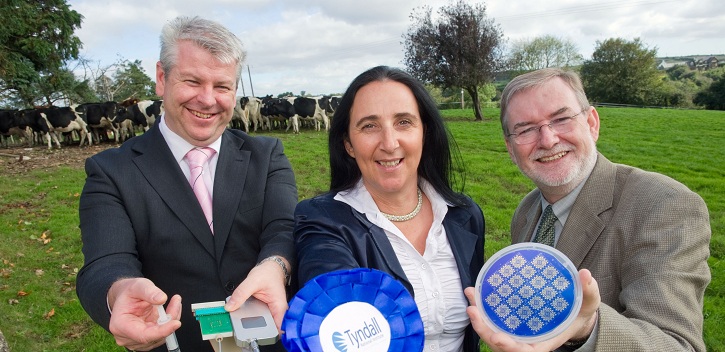2013 Press Releases
Diagnostic tool to revolutionise animal testing

Tyndall National Institute has launched a US-Ireland animal health research project, AgriSense, to diagnose Bovine Respiratory Disease (BRD) – Ireland’s No.1 cause of calf death.
The research will be conducted under a €900,000 R&D partnership between Tyndall, Georgia Institute of Technology and Queen’s University Belfast. The team will work to develop a sensor-based diagnostic kit to enable simultaneous testing for the four primary viral agents responsible for the disease and could facilitate field side testing for the first time with results in as little as 15 minutes.
Speaking at the launch, Simon Coveney TD, Minister for Agriculture, Food and the Marine, said “Bovine Respiratory Disease is responsible for in the region of 30% of deaths in stock under one-year old in Ireland and costs Irish farmers millions of euros each year in treatment and lost time to market. Affecting both beef and dairy herds, it is also a major source of lost revenue to the global agri-food industry. We need innovative ways of tackling this scourge and I am delighted that Tyndall has been chosen as a lead partner to lend its expertise in sensor technology to revolutionise farm-side testing.”
Dr Alan O’Riordan, Nanotechnology Group, Tyndall National Institute said: “The AgriSense project will explore the application of nano and sensor technology to provide a low-cost yet extremely precise and quick method of testing for use in animal health and disease diagnostics. The international team will work across Ireland, the US and Northern Ireland to explore how this technology can help in the fight against BRD, with livestock testing planned within the next three years.”
The sensors will be fabricated on disposable plastic testers to keep costs down and could reduce diagnosis time by up to four weeks. It is hoped that early detection and diagnosis will enable infected cattle to be isolated and could also facilitate more tailored treatment programmes eradicating the current practice of costly indiscriminate dosing to stop the spread of infection.
